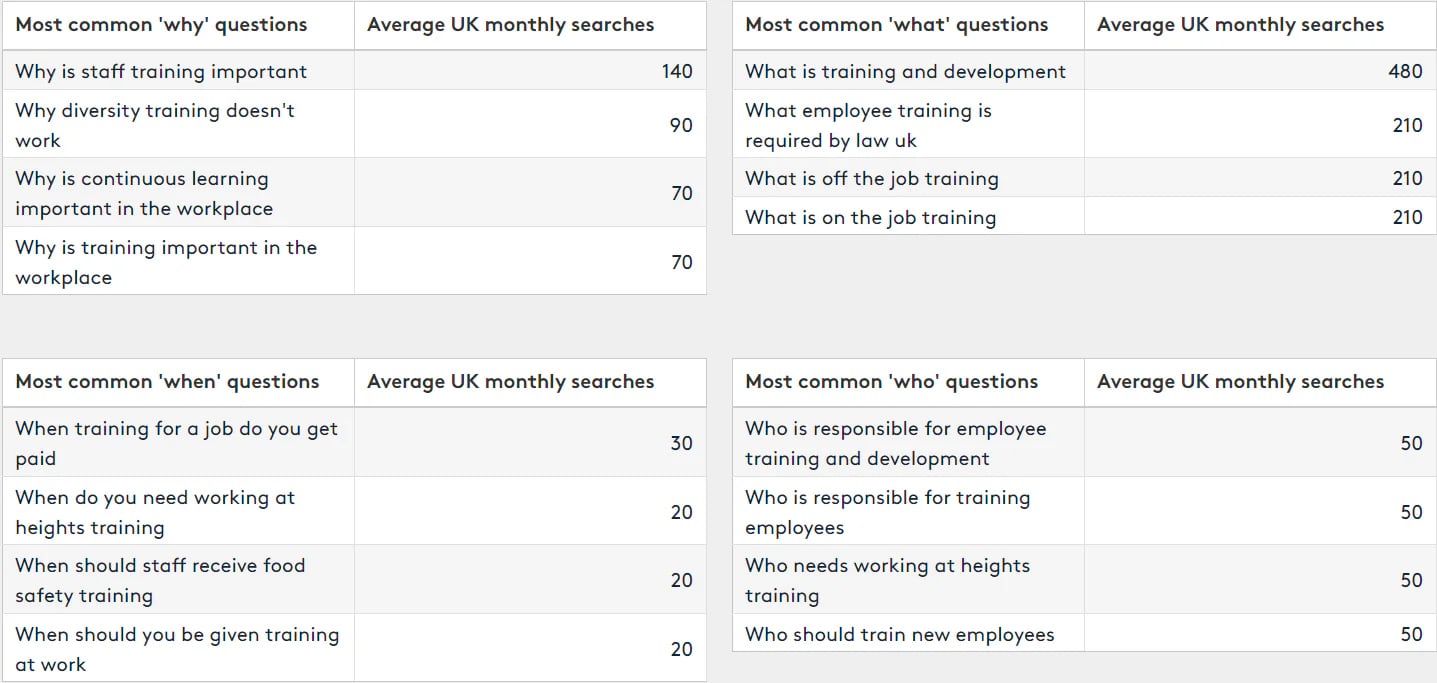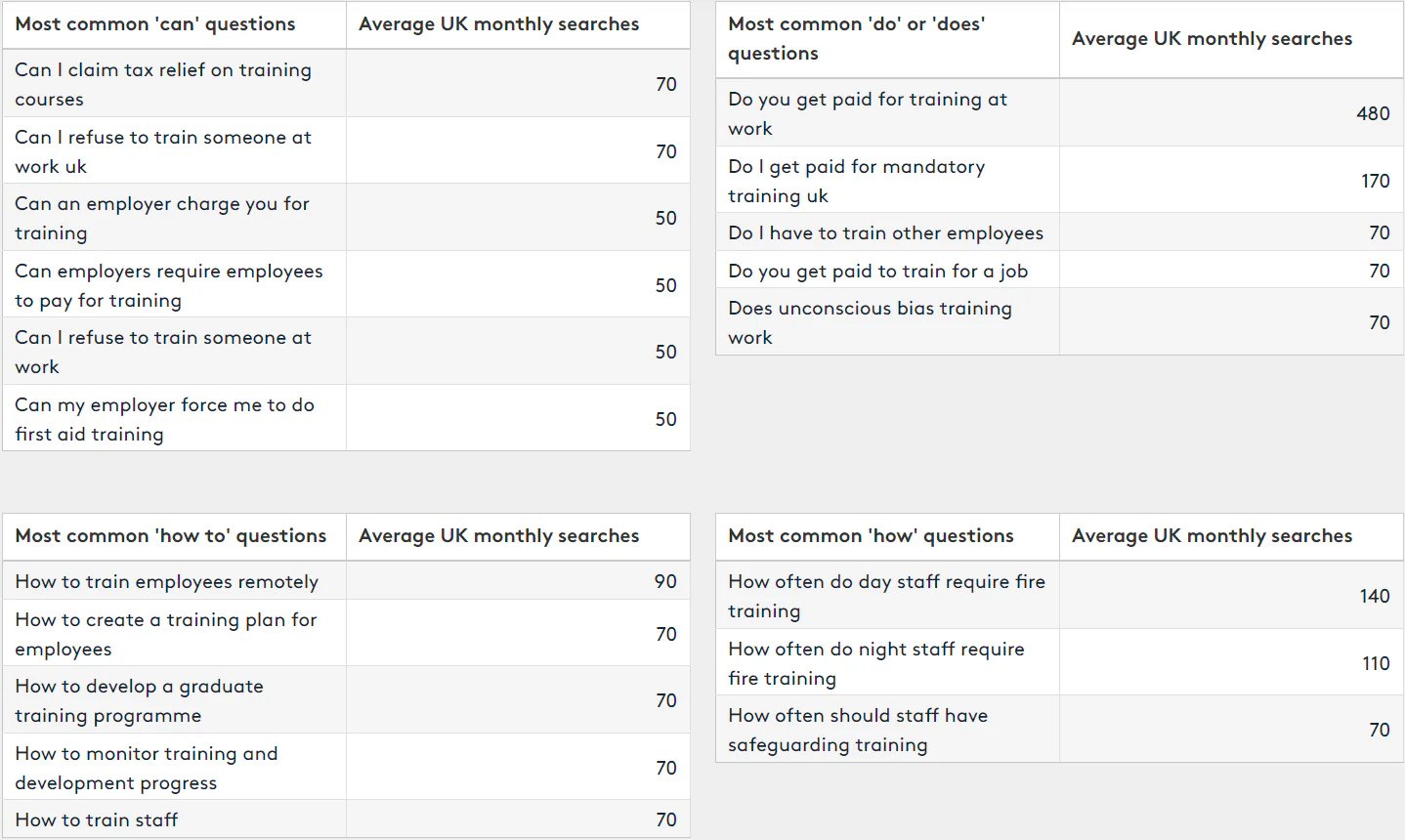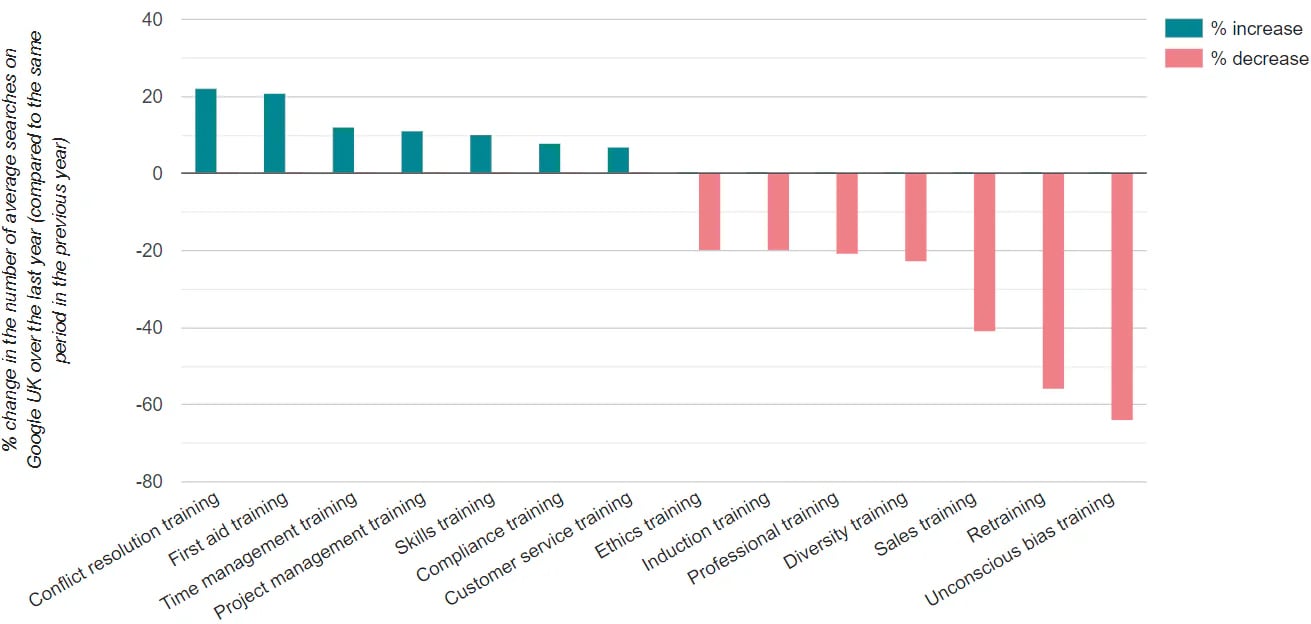Statistics and insights about staff training and workplace learning in the UK, including the most searched for types of employee training and development.
- Most searched for employee training-related questions on Google
- Top 50 most searched for types of employee training
- Most commonly Googled types of employee training over the last four years
- UK employee training statistics and trends
- Answers to top questions that people ask Google about staff training
The UK’s most searched for employee training-related questions on Google
Ciphr analysed thousands of search queries that mentioned training-related terms*, such as 'staff training', ‘training at work’, 'training and development', 'my manager + training' and 'workplace learning', to identify the most common questions that people ask Google about employee training.
Here's the top 10 most-searched-for questions about employee training in the UK, along with the average number of monthly searches on Google UK:
- Do you get paid for training at work? – 480
- What is training and development? – 480
- What employee training is required by law UK? – 210
- What is off the job training? – 210
- What is on the job training? – 210
- Do I get paid for mandatory training UK? – 170
- How often do day staff require fire training? – 140
- What is staff training? – 140
- Why is staff training important? – 140
- How often do night staff require fire training? – 110
- Should I be paid for mandatory online training UK? – 110
Questions about whether staff get paid for their time spent training dominate the results. 'Do you get paid for training at work?’ was the joint top question, with around 5,800 Google searches a year.
30% of the top 10 most Googled questions about employee training mention the word ‘paid’. While the words ‘pay’, 'paid and ‘charge’ feature in 22% of the top 108 employee training questions (with an average of over 50 Google searches a month) compiled by Ciphr.
The words ‘employee(s)’ or ‘staff’ appear in over a third (34%) of the top 108 training-related queries.
*Search terms included: Employee training, work training, staff training, training and development, workplace learning, workplace training, training at work, employer + training, my manager + training, company + training, my company + training, and boss + training. The data was collected between 2-3 August 2022 using Semrush.
Most asked questions
People turn to search engines, like Google, every day to fill their knowledge gaps and learn more about numerous subjects. Many are seeking answers to specific questions and most of those questions start with one of the 5Ws or something similar†.
According to Ciphr’s research, nearly half of the 750+ training-related questions revealed by the study begin with either ‘how to’ or ‘what’ (25% and 24% respectively). The next most popular searches are ‘how’ questions (14%), ‘why’ questions (12%) and ‘do or does’ questions (11%).
Here's some more examples of the most popular training-related questions that people ask Google about:


†The 5Ws are who, what, when, where and why. Other key question starters include: how, can, are, do or does, should, which, will, and is, among others.
Answers to some of the top questions that people ask Google about employee training
Ciphr's director of customer operations Bradley Burgoyne answers some of the most common employee training queries – including whether employers have to pay for training.
Do companies have to pay for training?
The answer will depend on an employee’s contract. If they were employed after 6 April 2020 the written terms must set out the training that the employee has to complete, including training the employer does not pay for. If they were employed before 6 April 2020, they can request clarification from their employer. It is, however, standard and best practice that employers pay for mandatory or statutory training that employees require to be able to do their job safely and effectively. Just because employers may not have to pay for training it doesn’t mean that they shouldn't, especially if there is a direct benefit to the organisation. If the training is going to help an employee do their job to a higher capability or, potentially, gives the employee scope to move into another role within the organisation that might fill a skills gap, then surely it makes good business sense for the employer to pay for it. It's a good investment in other ways, too. Research shows that most employees want to develop their skills and career. It’s a key part of what people are looking for in an employer when they are job hunting. Employers that embrace that, and agree there's a benefit to both parties when it comes to funding training, are more likely to retain their employees in the long run compared to employers that refuse to provide training.
Why is staff training important?
From a mandatory and legal perspective, employers have a moral and legal obligation to ensure that everyone that works within their organisation receives the required training for them to be able to do their job safely and effectively. That’s the bare minimum. Organisations that strive to be competitive and remain competitive for years into the future need to do so much more – they need to ensure that their employees' skills are kept up-to-date and evolve as required. Employers that choose to do this – and regard regular staff training as important – are likely to improve overall performance across the business. And, potentially, that's going to have a positive impact on profits, revenue, employee retention and the long-term viability of the organisation. The opposite is true for organisations that do not invest in training and developing their employees. At some point, they will probably have to buy that skill set by hiring new people, and that can become prohibitively expensive given the huge competition for talent across all industries.
What is off the job training?
Off the job training is when employees undertake training away from their place of work, through day release, online or distance learning, as well as block release courses. The most common example of this is within Apprenticeships, where apprentices attend workshops, complete e-learning or work on activities that are building new skills, knowledge, and behaviours that they don't currently have. The vast majority of off the job training usually occurs within the workplace during working hours, although some off-site courses are involved too. Again, the most common example is with apprenticeships, where apprentices are required to allocate 20% of their working day, week or year (however long their apprenticeship lasts) to off the job training. That doesn't mean they're not working, it just means they're enhancing their wider job knowledge, skills or learning new behaviours.
Can an employee refuse training?
Employers cannot force employees to do anything. However, if an employee refuses training that is required as part of the fulfilment of their terms and conditions or is a mandatory or legal requirement for their role, then their employment could be at risk. Employers have various legal responsibilities to ensure their employees' safety, including providing suitable safety training to prevent harm or injury to themselves and others. If, as an employee, you refuse to undertake this training then it may not be feasible for your employer to continue to employ you as it would put you all at risk. If the training is not mandatory, or a legal requirement, employees can still refuse, of course, as it’s voluntary training. They should be mindful though that there is probably going to be a knock-on effect of them refusing to do it. A good example of this would be an employee refusing upskilling training, or training on how to use a new piece of software or equipment, and then later finding themselves underperforming in their role because their skill set is out of date. That’s going to be a tricky situation to explain, as it could have been avoided. If the request to do the training was ultimately considered reasonable by the employer, and your refusal is preventing you from fulfilling your role and, ultimately, your contract of employment, then this could also put your ongoing employment at risk. As an employer, it’s important to understand the ‘why’ behind an employee’s refusal to undertake training. It could be that the employer just hasn’t done a great job of explaining why they want the person to complete the training and the benefits that the training will give them. If people know what the benefits are to them – how it will help them on their future career path – then they are much less likely to view it negatively and more likely to want to take part.
Do I have to train other employees?
If you work in a large organisation then there is probably an L&D function that takes care of the vast majority of training, with colleagues and line managers filling in any gaps. If you work in a smaller organisation, however, then more training responsibility is typically spread across existing team members. Where they may be called upon to help induct new employees or upskill colleagues on a new skill or process. In most instances, if it’s considered a reasonable request by the employer, employees should be careful around the long-term impact of refusing to assist with the training. That said, no one can make you do anything. And, the onus should never just be on you to train new recruits. If your employer has done nothing to equip you with the skills to be able to train someone, or they are not making any reasonable adjustments to your role knowing that it’s going to impact your performance, then it’s valid to question it as they are not making any allowances to help you help them.
Top 50 most searched for types of employee training
Ciphr analysed Google search data for over 100 different types of staff training that UK employers commonly provide‡ to identify the top 50 most searched for types of employee training in the UK over the past 12 months.
- People in the UK are more likely to Google ‘first aid training’ than any other type of employee training
- First aid training, upskilling, and manual handling training were the three most Googled types of employee training, with a combined 16,000 average monthly searches
- Six of the top 10 most searched for types of employee training relate to health and safety, such as driver training, safeguarding training and COSHH (control of substances hazardous to health) training

Confidence training, mentoring training, digital skills training, challenging behaviour training, performance management training, stress management training, quality assurance training, and complaints handling training are some of the other types of training that average over 100 Google searches each a month.
‡This is not an exhaustive list of all types of employee training. Similar types of employee training have been removed from the results. For example, there were more searches for the term ‘diversity training’ than the terms 'equality training', ‘diversity and inclusion training’, ‘diversity equality and inclusion training’ or ‘DEI training’, so ‘diversity training’ was included in the results while the others were not. The data was collected between 2-3 August 2022 using KWfinder.
Has interest in the types of employee training changed?
Ciphr’s research shows that there have been some changes to the types of employee training that people have asked Google about over the last year.
- The number of searches for the term ‘conflict resolution training’ has risen by 22% over the last year
- The number of searches for first aid training and time management training were also up – 21% and 12% respectively.
- The number of searches for the terms ‘retraining’ and ‘sales training’ have fallen by 56% and 41% respectively over the last year (both are still among the top 10 most Googled though)
- Unconscious bias training has also fallen in popularity, with over 60% less searches on Google UK
The chart below shows which types of employer training were looked up more often and which types fell in Google search popularity between July 2021 and June 2022 (top seven in each category included):

Most-Googled types of employee training over the last four years
There have been less changes than you might expect to the top 10 most-Googled types of employee training over the last four years:
- First aid training and upskilling are consistently Googled more than other types of employee training
- Retraining, unconscious bias training††and sales training were the third, fourth and fifth most popular types of employee training that people asked Google about between July 2020 and June 2021 (during the first year of the pandemic).
††The number of average monthly Google searches for the term ‘unconscious bias training’ rose a significant 167% between July 2020–June 2021, from 1,139 to 3,042.
Employee training statistics in the UK in 2022
Here’s a roundup of some of the latest UK employee training research and statistics:
- Millions of UK workers aren’t receiving regular training Around half (48%) of organisations have not provided their employee with any training in the last year. According to the government’s latest Employer Pulse Survey, employees in the South East are among the least likely to have received training, compared to those in the East Midlands (43% vs 58%). (Source: Department for Education)
- L&D initiatives can boost recruitment Training provisions can be as important to job seekers as non-monetary benefits, salary, and working hours. Nearly a third of people (28%) wouldn’t apply for a job with an employer that doesn’t invest in training and development. (Source: Ciphr)
- Higher salary is key driver for retraining Since the start of the pandemic, nearly one in three (30%) people have reportedly retrained or changed the industry they work in. The three top reasons for career retraining are earning higher pay, upskilling, and improving work-life balance. (Source: Ciphr)
- Regular management training aids retention Nearly two-thirds (65%) of UK managers don’t receive regular management training from their employers (26% haven’t even had any management training). So, it’s probably not too surprising to learn that managers who haven’t received any management training are 36% more likely to leave their current jobs than managers who get regular management training (38% compared to 28%). (Source: Ciphr)
- Upskilling staff can combat recruitment challenges While wage increases are still the most popular way for employers to fill vacancies and retain staff, many organisations are placing a renewed focus on upskilling. Over a third (37%) plan to upskill their existing employees to help offset skills gaps in their organisation. (Source: CIPD)
- Cheaper to upskill than hire Many (79%) UK L&D professionals think it’s less costly to upskill or reskill an existing employee than hire a new employee to fill widening skills gaps. The research, published by LinkedIn’s 2022 Workplace Learning Report, also revealed that 41% of companies plan to implement large-scale upskilling or reskilling programmes this year. (Source: LinkedIn)
This content was initially published on Digits.co.uk, a Ciphr Company.
